サポートベクタマシン実装編; Code of Support Vector Machine
概要
この記事ではサポートベクタマシンの実行サンプル、結果、そして実装について述べる。
サポートベクタマシンの理論についてはこちら
実行サンプルおよび結果では線形分離可能、線形分離不可能、ランダム配置時の3パターンを以下に示す。
以降の画像は左が線形サポートベクタマシン、右がガウシアンサポートベクタマシンの結果になる。
Costを大きくすれば誤識別は少なくなるが、過学習が起きやすくなる。
線形分離可能
const double cost = 10000;
List<Vector> positive_vectors = new List<Vector>(), negative_vectors = new List<Vector>();
positive_vectors.Add(new Vector(-1.0, -1.0));
positive_vectors.Add(new Vector( 0.0, -1.0));
positive_vectors.Add(new Vector(+1.0, -1.0));
positive_vectors.Add(new Vector(+0.4, -0.8));
positive_vectors.Add(new Vector(-1.0, -0.6));
positive_vectors.Add(new Vector(-0.6, -0.6));
positive_vectors.Add(new Vector(-0.2, -0.6));
positive_vectors.Add(new Vector(+0.8, -0.6));
positive_vectors.Add(new Vector(-0.8, -0.4));
positive_vectors.Add(new Vector(+0.2, -0.4));
positive_vectors.Add(new Vector(-0.4, -0.2));
positive_vectors.Add(new Vector(-0.8, 0.0));
negative_vectors.Add(new Vector(+0.8, -0.4));
negative_vectors.Add(new Vector(+0.4, -0.2));
negative_vectors.Add(new Vector( 0.0, 0.0));
negative_vectors.Add(new Vector(+0.8, 0.0));
negative_vectors.Add(new Vector(-0.8, +0.2));
negative_vectors.Add(new Vector(-0.4, +0.4));
negative_vectors.Add(new Vector( 0.0, +0.4));
negative_vectors.Add(new Vector(+0.6, +0.4));
negative_vectors.Add(new Vector(+1.0, +0.4));
negative_vectors.Add(new Vector(-1.0, +0.6));
negative_vectors.Add(new Vector(-0.6, +0.8));
negative_vectors.Add(new Vector(+0.6, +0.8));
negative_vectors.Add(new Vector(+0.2, +1.0));
SupportVectorMachine linear_svm = new LinearSupportVectorMachine(cost: cost);
linear_svm.Learn(2, positive_vectors, negative_vectors);
Plot(linear_svm, positive_vectors, negative_vectors, $"s1_linear_cost{cost}_svm.png");
SupportVectorMachine gaussian_svm = new GaussianSupportVectorMachine(cost: cost, sigma:1);
gaussian_svm.Learn(2, positive_vectors, negative_vectors);
Plot(gaussian_svm, positive_vectors, negative_vectors, $"s1_gaussian_cost{cost}_svm.png");
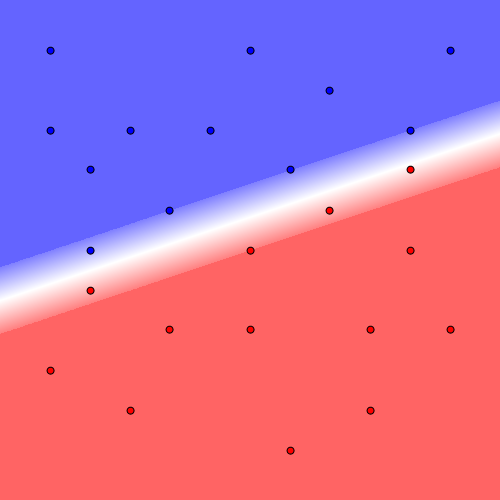
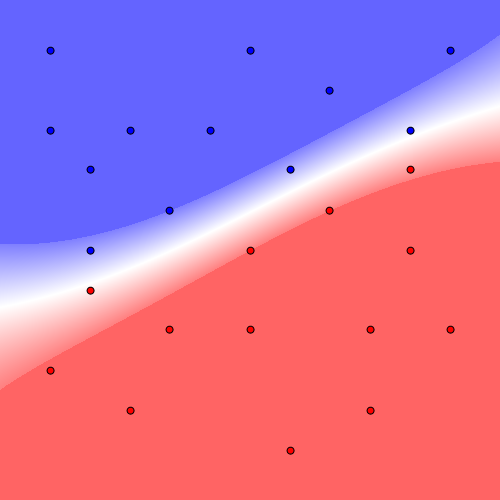
Cost=100
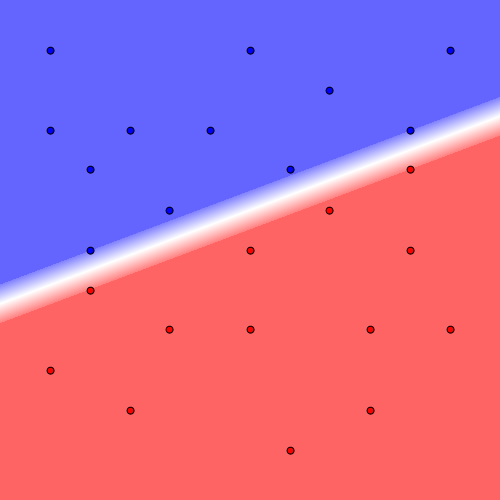
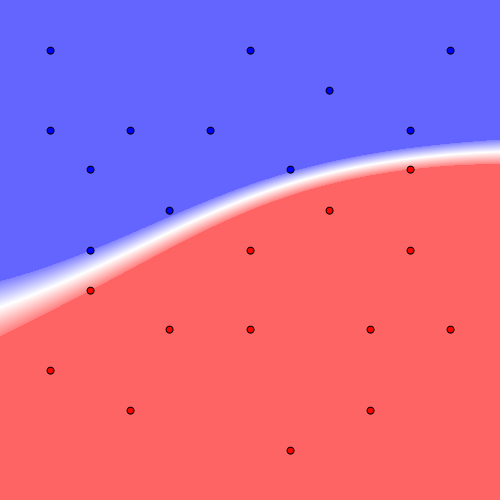
Cost=1000
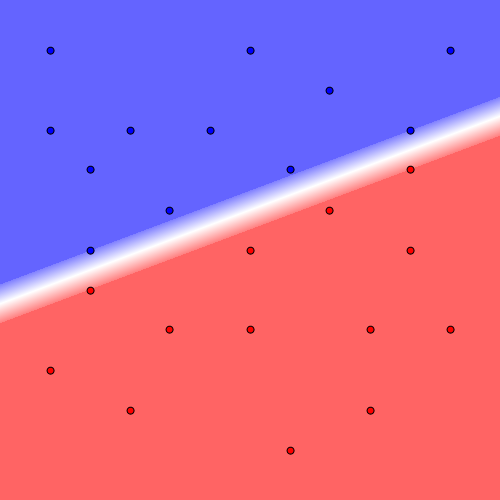
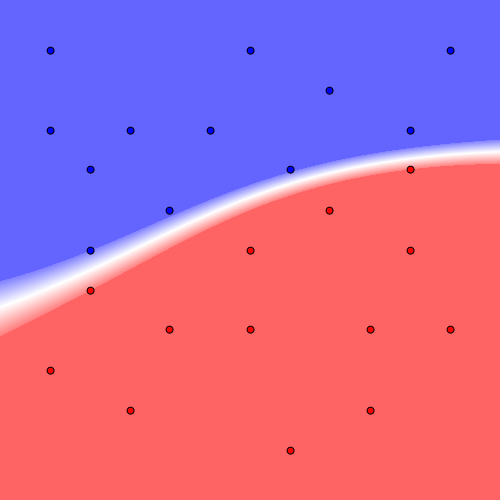
Cost=10000
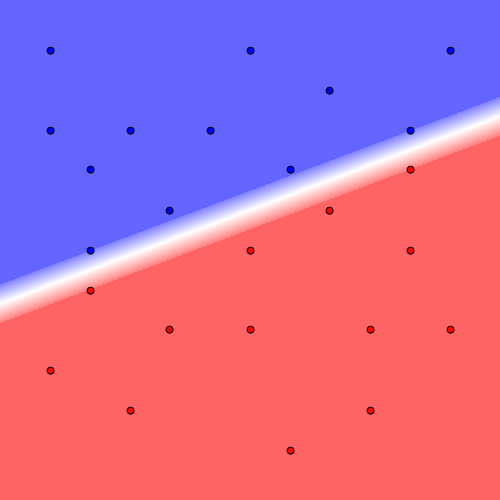
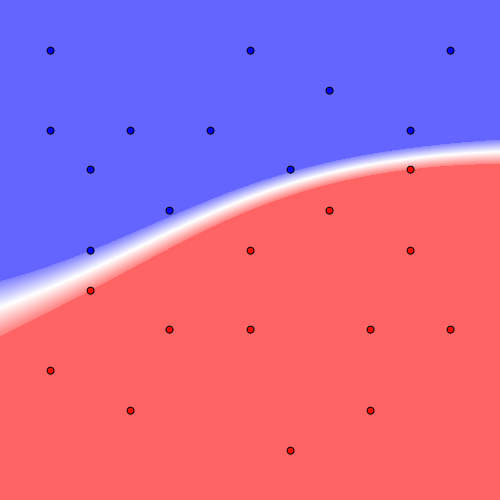
線形分離不可能
const double cost = 10000;
List<Vector> positive_vectors = new List<Vector>(), negative_vectors = new List<Vector>();
positive_vectors.Add(new Vector(-1, +1));
positive_vectors.Add(new Vector(+1, -1));
negative_vectors.Add(new Vector(+1, +1));
negative_vectors.Add(new Vector(-1, -1));
SupportVectorMachine linear_svm = new LinearSupportVectorMachine(cost: cost);
linear_svm.Learn(2, positive_vectors, negative_vectors);
Plot(linear_svm, positive_vectors, negative_vectors, $"s2_linear_cost{cost}_svm.png");
SupportVectorMachine gaussian_svm = new GaussianSupportVectorMachine(cost: cost, sigma:1);
gaussian_svm.Learn(2, positive_vectors, negative_vectors);
Plot(gaussian_svm, positive_vectors, negative_vectors, $"s2_gaussian_cost{cost}_svm.png");
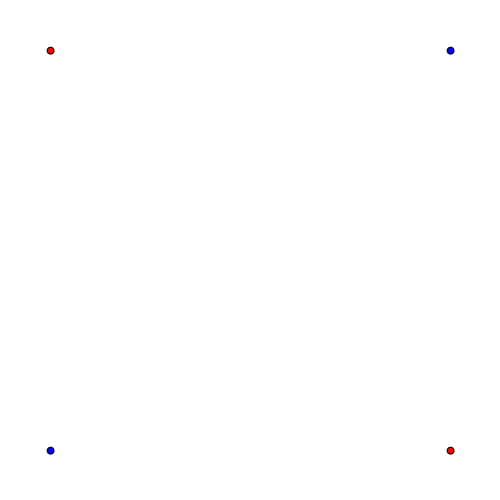
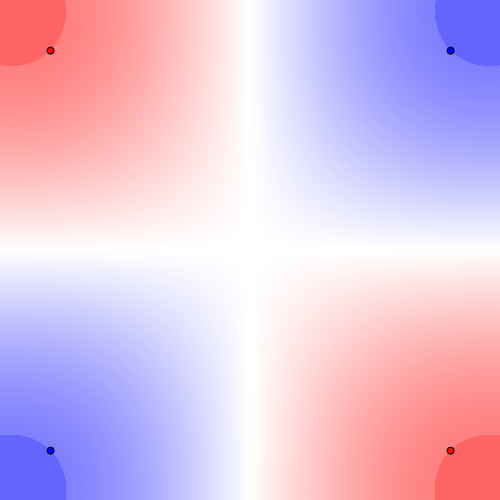
Cost=100
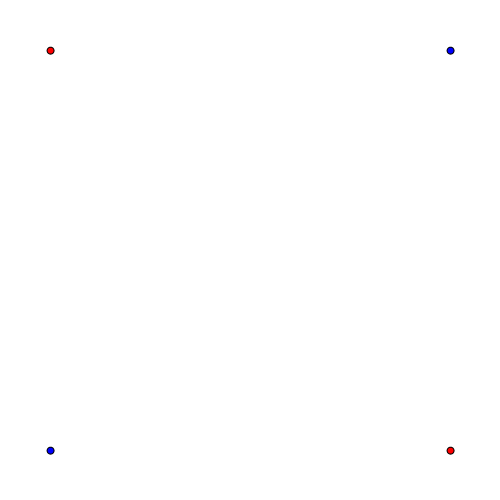
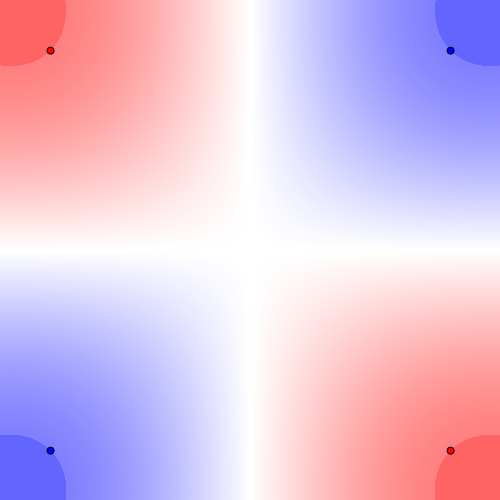
Cost=1000
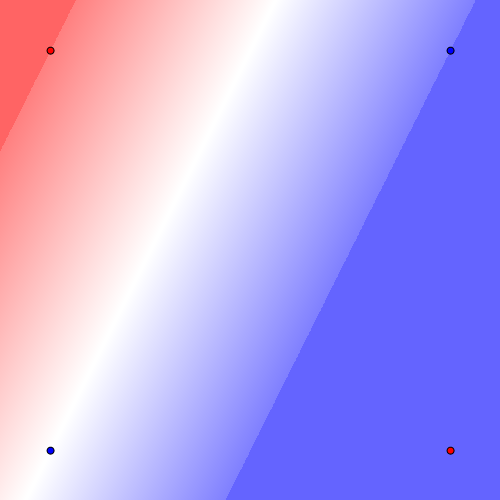
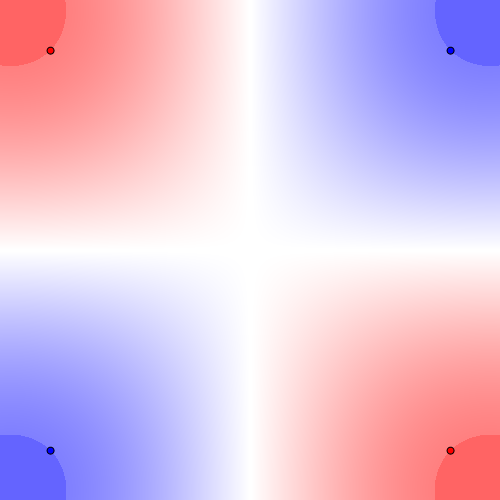
Cost=10000
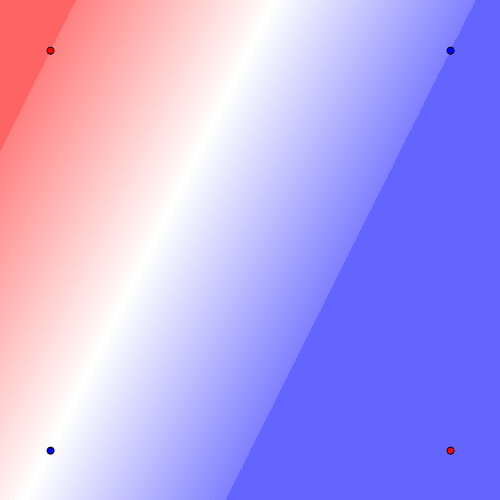
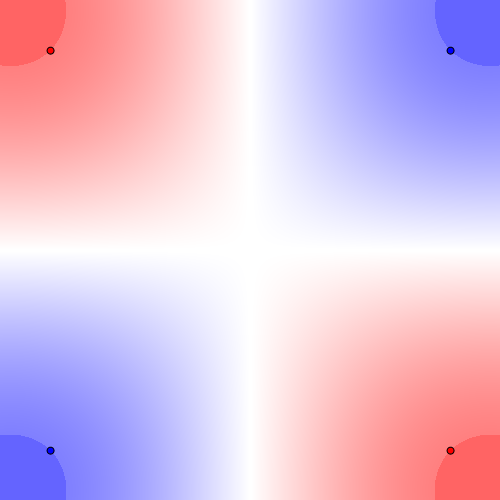
ランダム配置
Random random = new Random(10);
const double cost = 10000;
List<Vector> positive_vectors = new List<Vector>(), negative_vectors = new List<Vector>();
Vector positive_center = new Vector(-0.5, -0.5), negative_center = new Vector(+0.5, +0.5);
for(int i = 0; i < 25; i++) {
positive_vectors.Add(positive_center + new Vector(1.8 * random.NextDouble() - 0.9, 1.8 * random.NextDouble() - 0.9));
}
for(int i = 0; i < 20; i++) {
negative_vectors.Add(negative_center + new Vector(1.8 * random.NextDouble() - 0.9, 1.8 * random.NextDouble() - 0.9));
}
SupportVectorMachine linear_svm = new LinearSupportVectorMachine(cost: cost);
linear_svm.Learn(2, positive_vectors, negative_vectors);
Plot(linear_svm, positive_vectors, negative_vectors, $"s3_linear_cost{cost}_svm.png");
SupportVectorMachine gaussian_svm = new GaussianSupportVectorMachine(cost: cost, sigma:1);
gaussian_svm.Learn(2, positive_vectors, negative_vectors);
Plot(gaussian_svm, positive_vectors, negative_vectors, $"s3_gaussian_cost{cost}_svm.png");
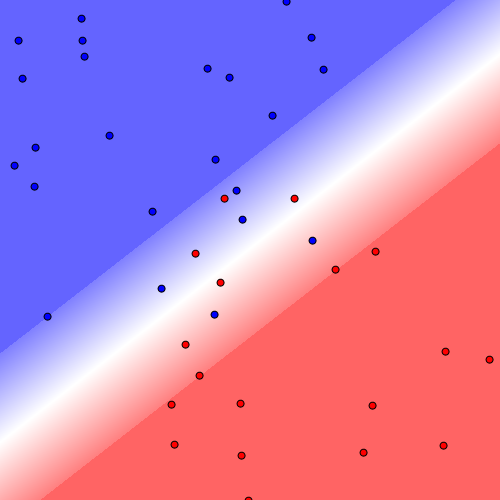
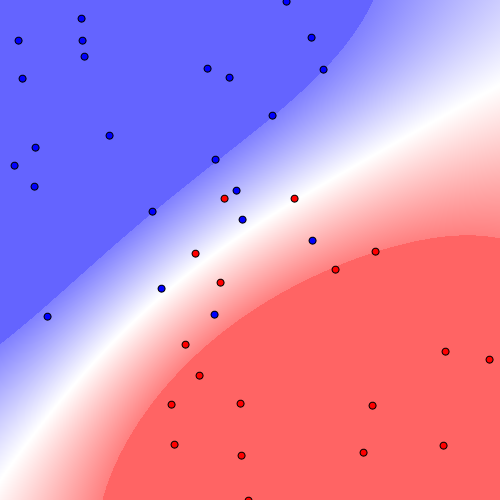
Cost=100
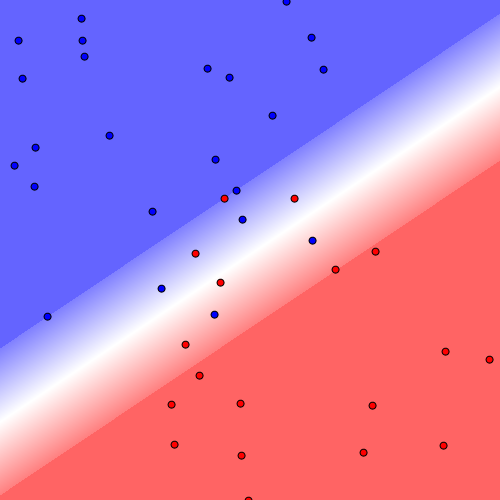
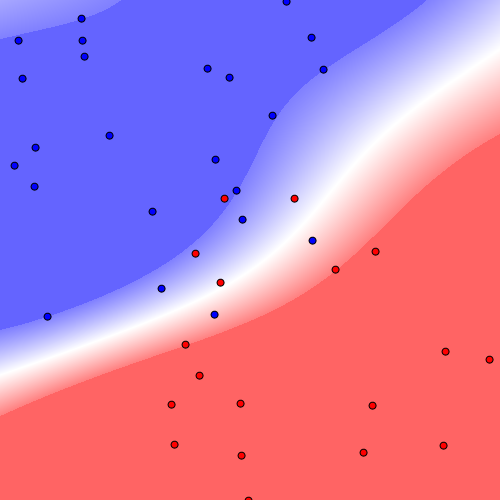
Cost=1000
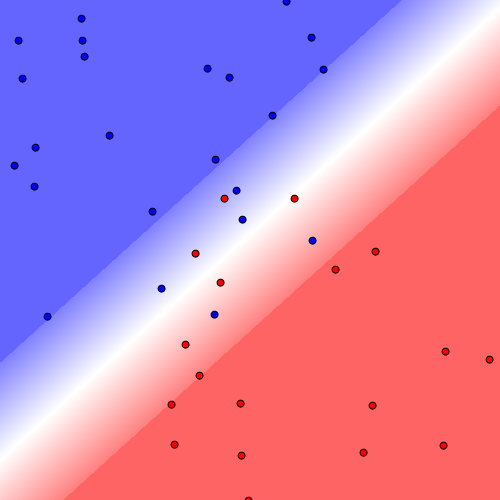
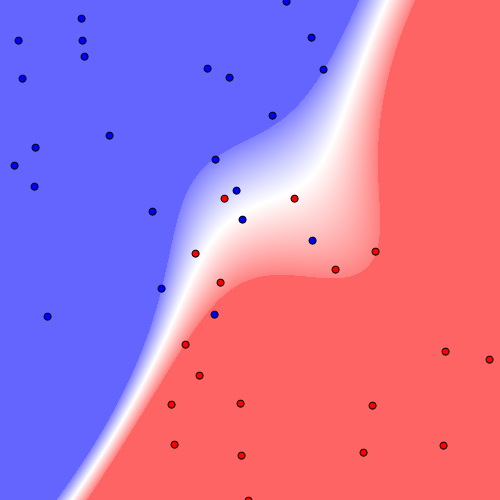
Cost=10000
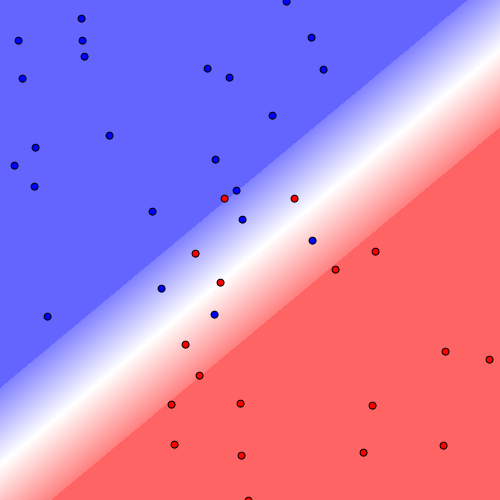
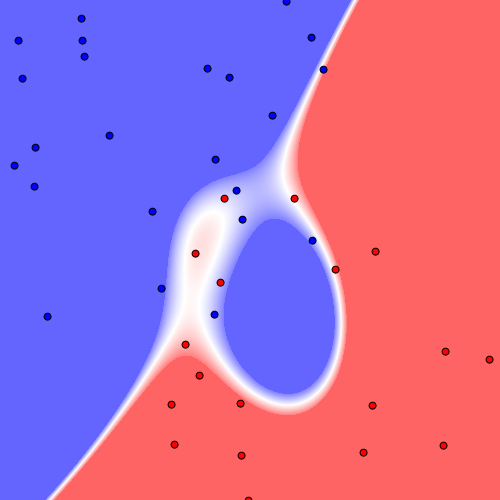
サンプルコードPlot関数
static void Plot(SupportVectorMachine svm, List<Vector> positive_vectors, List<Vector> negative_vectors, string filepath) {
Bitmap image = new Bitmap(500, 500);
Func<double, Color> color_func = (s) => {
int d = (int)((Math.Abs(s) >= 1) ? 100 : (256 - 128 * Math.Abs(s)));
if(Math.Abs(s) < 1.0e-4) {
return Color.FromArgb(255, 255, 255);
}
return (s < 0) ? Color.FromArgb(255, d, d) : Color.FromArgb(d, d, 255);
};
for(int x, y = 0; y < image.Height; y++) {
for(x = 0; x < image.Width; x++) {
double vx = (x - image.Width / 2) / (image.Width * 0.4);
double vy = (y - image.Height / 2) / (image.Height * 0.4);
double s = svm.ClassifyRaw(new Vector(vx, vy));
image.SetPixel(x, y, color_func(s));
}
}
using(Graphics g = Graphics.FromImage(image)) {
g.SmoothingMode = System.Drawing.Drawing2D.SmoothingMode.HighQuality;
foreach(var positive_vector in positive_vectors) {
int x = (int)((4 * positive_vector.X + 5) / 10 * image.Width);
int y = (int)((4 * positive_vector.Y + 5) / 10 * image.Height);
g.DrawEllipse(new Pen(Color.Black, 2), new Rectangle(new Point(x - 3, y - 3), new Size(6, 6)));
g.FillEllipse(new SolidBrush(Color.Blue), new Rectangle(new Point(x - 3, y - 3), new Size(6, 6)));
}
foreach(var negative_vector in negative_vectors) {
int x = (int)((4 * negative_vector.X + 5) / 10 * image.Width);
int y = (int)((4 * negative_vector.Y + 5) / 10 * image.Height);
g.DrawEllipse(new Pen(Color.Black, 2), new Rectangle(new Point(x - 3, y - 3), new Size(6, 6)));
g.FillEllipse(new SolidBrush(Color.Red), new Rectangle(new Point(x - 3, y - 3), new Size(6, 6)));
}
}
image.Save(filepath, ImageFormat.Png);
}
サポートベクタマシンのコード
namespace Clustering {
/// <summary>線形サポートベクタマシン</summary>
public class LinearSupportVectorMachine : SupportVectorMachine {
/// <summary>コンストラクタ</summary>
/// <param name="cost">誤識別に対するペナルティの大きさ</param>
public LinearSupportVectorMachine(double cost) : base(cost){ }
/// <summary>カーネル関数</summary>
protected override double Kernel(Vector vector1, Vector vector2) {
double sum = 0;
for(int i = 0; i < VectorDim; i++) {
sum += vector1[i] * vector2[i];
}
return sum;
}
}
/// <summary>ガウシアンサポートベクタマシン</summary>
public class GaussianSupportVectorMachine : SupportVectorMachine {
private double sigma, gamma;
/// <param name="cost">誤識別に対するペナルティの大きさ</param>
/// <param name="sigma">ガウシアン関数の尺度パラメータ</param>
public GaussianSupportVectorMachine(double cost, double sigma) : base(cost){
this.Sigma = sigma;
}
/// <summary>ガウシアン関数の尺度パラメータ</summary>
public double Sigma {
get {
return sigma;
}
protected set {
sigma = value;
gamma = 1 / (2 * sigma * sigma);
}
}
/// <summary>カーネル関数</summary>
protected override double Kernel(Vector vector1, Vector vector2) {
double norm = 0;
for(int i = 0; i < vector1.Dim; i++) {
double d = vector1[i] - vector2[i];
norm += d * d;
}
return Math.Exp(-gamma * norm);
}
}
/// <summary>サポートベクタマシン</summary>
public abstract class SupportVectorMachine : IClusteringMethod {
protected class WeightVector {
public Vector Vector { get; set; }
public double Weight { get; set; }
}
double bias, cost;
List<WeightVector> support_vectors;
/// <summary>コンストラクタ</summary>
/// <param name="cost">誤識別に対するペナルティの大きさ</param>
public SupportVectorMachine(double cost) {
if(!(cost > 0)) {
throw new ArgumentException(nameof(cost));
}
Initialize();
this.cost = cost;
}
/// <summary>データクラス数</summary>
/// <remarks>SVMは常に2</remarks>
public int GroupCount => 2;
/// <summary>ベクトルの次元数</summary>
public int VectorDim {
get; private set;
}
/// <summary>単一サンプルを分類</summary>
/// <param name="vector">サンプルベクタ</param>
public int Classify(Vector vector) {
return ClassifyRaw(vector) > 0 ? +1 : ClassifyRaw(vector) < 0 ? -1 : 0;
}
/// <summary>単一サンプルを分類</summary>
/// <param name="vector">サンプルベクタ</param>
/// <param name="threshold">弁別しきい値</param>
public int Classify(Vector vector, double threshold) {
return ClassifyRaw(vector) > threshold ? +1 : ClassifyRaw(vector) < -threshold ? -1 : 0;
}
/// <summary>複数サンプルを分類</summary>
/// <param name="vectors">サンプルベクタ集合</param>
public IEnumerable<int> Classify(IEnumerable<Vector> vectors) {
return vectors.Select((vector) => Classify(vector));
}
/// <summary>複数サンプルを分類</summary>
/// <param name="vectors">サンプルベクタ集合</param>
/// <param name="threshold">弁別しきい値</param>
public IEnumerable<int> Classify(IEnumerable<Vector> vectors, double threshold) {
return vectors.Select((vector) => Classify(vector, threshold));
}
/// <summary>単一サンプルの識別値</summary>
public double ClassifyRaw(Vector vector) {
if(vector == null || vector.Dim != VectorDim) {
throw new ArgumentException();
}
double s = -bias;
foreach(var support_vector in support_vectors) {
s += support_vector.Weight * Kernel(vector, support_vector.Vector);
}
return s;
}
/// <summary>複数サンプルの識別値</summary>
public IEnumerable<double> ClassifyRaw(IEnumerable<Vector> vectors) {
return vectors.Select((vector) => ClassifyRaw(vector));
}
/// <summary>学習</summary>
/// <param name="vector_dim">サンプルベクタ次元数</param>
/// <param name="vectors_groups">データクラスごとのサンプルベクタ集合</param>
/// <remarks>サンプルベクタ集合は正例と負例の2つ</remarks>
public void Learn(int vector_dim, params List<Vector>[] vectors_groups) {
Initialize();
ValidateSample(vector_dim, vectors_groups);
// サポートベクターとなる最小のベクトル重み
double epsilon = 1.0e-3;
// ベクトルの次元数
VectorDim = vector_dim;
// ベクトル
List<Vector> positive_vectors = vectors_groups[0];
List<Vector> negative_vectors = vectors_groups[1];
List<Vector> inputs = new List<Vector>();
inputs.AddRange(positive_vectors);
inputs.AddRange(negative_vectors);
// ラベル
double[] outputs = (new double[inputs.Count]).Select((_, i) => i < positive_vectors.Count ? +1.0 : -1.0).ToArray();
// 逐次最小問題最適化法実行
var smo = new SequentialMinimalOptimization(inputs.ToArray(), outputs, cost, Kernel);
smo.Optimize();
bias = smo.Bias;
double[] vector_weight = smo.VectorWeight;
//サポートベクターの格納
for(int i = 0; i < vector_weight.Length; i++) {
if(vector_weight[i] > epsilon) {
var wvec = new WeightVector { Weight = vector_weight[i] * outputs[i], Vector = (Vector)inputs[i].Clone() };
support_vectors.Add(wvec);
}
}
}
/// <summary>カーネル関数</summary>
protected abstract double Kernel(Vector vector1, Vector vector2);
/// <summary>初期化</summary>
public void Initialize() {
bias = 0;
support_vectors = new List<WeightVector>();
}
/// <summary>サンプルの正当性を検証</summary>
private void ValidateSample(int vector_dim, List<Vector>[] vectors_groups) {
if(vector_dim < 1) {
throw new ArgumentException(nameof(vector_dim));
}
if(vectors_groups == null) {
throw new ArgumentNullException(nameof(vectors_groups));
}
if(vectors_groups.Length != GroupCount) {
throw new ArgumentException(nameof(vectors_groups));
}
foreach(var vectors in vectors_groups) {
if(vectors.Count < 1) {
throw new ArgumentException(nameof(vectors_groups));
}
foreach(var vector in vectors) {
if(vector.Dim != vector_dim) {
throw new ArgumentException(nameof(vectors_groups));
}
}
}
}
}
}
逐次最小問題最適化法のコード
namespace Clustering {
/// <summary>逐次最小問題最適化法</summary>
public class SequentialMinimalOptimization {
private int vectors;
private Vector[] inputs;
private double[] outputs;
private double bias, cost, tolerance, epsilon;
private double[] a, errors;
private Random random;
private Func<Vector, Vector, double> kernel;
/// <summary>コンストラクタ</summary>
public SequentialMinimalOptimization(Vector[] inputs, double[] outputs, double cost, Func<Vector, Vector, double> kernel) {
this.vectors = inputs.Length;
this.inputs = inputs;
this.outputs = outputs;
this.cost = cost;
this.kernel = kernel;
}
/// <summary>ベクトル重み</summary>
public double[] VectorWeight => a;
/// <summary>バイアス</summary>
public double Bias => bias;
/// <summary>最適化シークエンスを実行</summary>
public void Optimize() {
errors = new double[vectors];
random = new Random(0);
a = new double[vectors];
bias = 0;
tolerance = 1e-3;
epsilon = 1e-3;
int changed_count = 0;
bool examine_all = true;
while(changed_count > 0 || examine_all) {
changed_count = 0;
if(examine_all) {
for(int i = 0; i < vectors; i++)
changed_count += ExamineExample(i);
}
else {
for(int i = 0; i < vectors; i++)
if(a[i] != 0 && a[i] != cost)
changed_count += ExamineExample(i);
}
if(examine_all)
examine_all = false;
else if(changed_count == 0)
examine_all = true;
}
}
/// <summary>i2と同時に最適化するi1を探索し2パラメータの最適化を実行</summary>
private int ExamineExample(int i2) {
int i1;
Vector v2 = inputs[i2];
double y2 = outputs[i2];
double a2 = a[i2];
double e2 = (a2 > 0 && a2 < cost) ? errors[i2] : ComputeF(v2) - y2;
double r2 = y2 * e2;
if(!(r2 < -tolerance && a2 < cost) && !(r2 > tolerance && a2 > 0))
return 0;
// 誤差値の差分を最大化するi1の探索
i1 = i2;
double maxerr = 0;
for(int i = 0; i < inputs.Length; i++) {
if(i == i2)
continue;
if(a[i] > 0 && a[i] < cost) {
double e1 = errors[i];
double err = Math.Abs(e2 - e1);
if(err > maxerr) {
maxerr = err;
i1 = i;
}
}
}
if(i1 != i2 && TakeStep(i1, i2))
return 1;
// i1をランダムに決定
int start = random.Next(inputs.Length);
for(i1 = start; i1 < inputs.Length; i1++) {
if(a[i1] > 0 && a[i1] < cost)
if(TakeStep(i1, i2))
return 1;
}
for(i1 = 0; i1 < start; i1++) {
if(a[i1] > 0 && a[i1] < cost)
if(TakeStep(i1, i2))
return 1;
}
start = random.Next(inputs.Length);
for(i1 = start; i1 < inputs.Length; i1++) {
if(TakeStep(i1, i2))
return 1;
}
for(i1 = 0; i1 < start; i1++) {
if(TakeStep(i1, i2))
return 1;
}
return 0;
}
/// <summary>2パラメータの最適化を実行</summary>
private bool TakeStep(int i1, int i2) {
if(i1 == i2)
return false;
Vector v1 = inputs[i1], v2 = inputs[i2];
double a1_old = a[i1], a2_old = a[i2];
double y1 = outputs[i1], y2 = outputs[i2];
double e1 = (a1_old > 0 && a1_old < cost) ? errors[i1] : ComputeF(v1) - y1;
double e2 = (a2_old > 0 && a2_old < cost) ? errors[i2] : ComputeF(v2) - y2;
double s = y1 * y2;
// a1,a2を最適化
double clip_l, clip_h;
if(y1 != y2) {
clip_l = Math.Max(0, a2_old - a1_old);
clip_h = Math.Min(cost, cost + a2_old - a1_old);
}
else {
clip_l = Math.Max(0, a2_old + a1_old - cost);
clip_h = Math.Min(cost, a2_old + a1_old);
}
if(clip_l >= clip_h)
return false;
double k11, k22, k12, eta;
k11 = kernel(v1, v1);
k12 = kernel(v1, v2);
k22 = kernel(v2, v2);
eta = k11 + k22 - 2 * k12;
double a1_new, a2_new;
if(eta > 0) {
a2_new = a2_old - y2 * (e2 - e1) / eta;
if(a2_new < clip_l)
a2_new = clip_l;
else if(a2_new > clip_h)
a2_new = clip_h;
}
else {
double l1 = a1_old + s * (a2_old - clip_l);
double h1 = a1_old + s * (a2_old - clip_h);
double f1 = y1 * (e1 + bias) - a1_old * k11 - s * a2_old * k12;
double f2 = y2 * (e2 + bias) - a2_old * k22 - s * a1_old * k12;
double obj_l = -0.5 * l1 * l1 * k11 - 0.5 * clip_l * clip_l * k22 - s * clip_l * l1 * k12 - l1 * f1 - clip_l * f2;
double obj_h = -0.5 * h1 * h1 * k11 - 0.5 * clip_h * clip_h * k22 - s * clip_h * h1 * k12 - h1 * f1 - clip_h * f2;
if(obj_l > obj_h + epsilon)
a2_new = clip_l;
else if(obj_l < obj_h - epsilon)
a2_new = clip_h;
else
a2_new = a2_old;
}
if(Math.Abs(a2_new - a2_old) < epsilon * (a2_new + a2_old + epsilon))
return false;
a1_new = a1_old + s * (a2_old - a2_new);
if(a1_new < 0) {
a2_new += s * a1_new;
a1_new = 0;
}
else if(a1_new > cost) {
double d = a1_new - cost;
a2_new += s * d;
a1_new = cost;
}
// バイアスを更新
double b1 = 0, b2 = 0;
double new_bias = 0, delta_bias;
if(a1_new > 0 && a1_new < cost) {
new_bias = e1 + y1 * (a1_new - a1_old) * k11 + y2 * (a2_new - a2_old) * k12 + bias;
}
else {
if(a2_new > 0 && a2_new < cost) {
new_bias = e2 + y1 * (a1_new - a1_old) * k12 + y2 * (a2_new - a2_old) * k22 + bias;
}
else {
b1 = e1 + y1 * (a1_new - a1_old) * k11 + y2 * (a2_new - a2_old) * k12 + bias;
b2 = e2 + y1 * (a1_new - a1_old) * k12 + y2 * (a2_new - a2_old) * k22 + bias;
new_bias = (b1 + b2) / 2;
}
}
delta_bias = new_bias - bias;
bias = new_bias;
// 誤差値を更新
double t1 = y1 * (a1_new - a1_old);
double t2 = y2 * (a2_new - a2_old);
for(int i = 0; i < inputs.Length; i++) {
if(0 < a[i] && a[i] < cost) {
Vector vi = inputs[i];
errors[i] += t1 * kernel(v1, vi) + t2 * kernel(v2, vi) - delta_bias;
}
}
errors[i1] = errors[i2] = 0;
// a1,a2を格納
a[i1] = a1_new;
a[i2] = a2_new;
return true;
}
/// <summary>F値を計算</summary>
private double ComputeF(Vector v) {
double sum = -bias;
for(int i = 0; i < inputs.Length; i++) {
if(a[i] > 0)
sum += a[i] * outputs[i] * kernel(inputs[i], v);
}
return sum;
}
}
}
クラスタリング手法インタフェースクラス
サポートベクタマシン理論編
